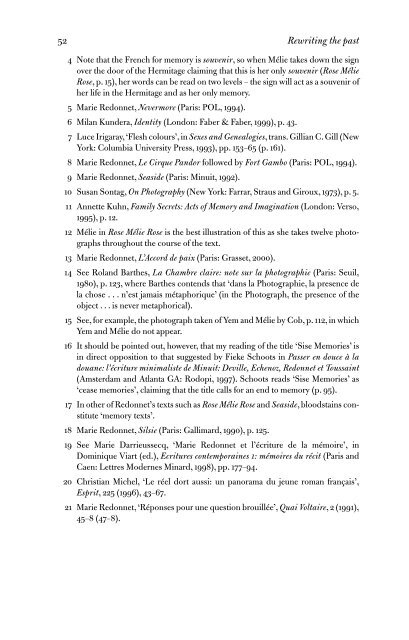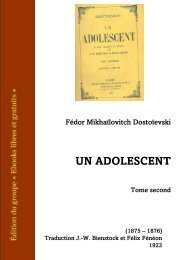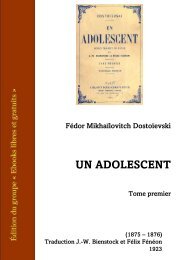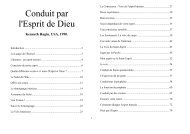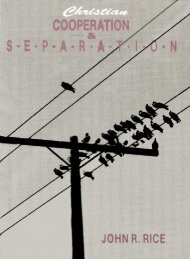Women writing in contemporary France
You also want an ePaper? Increase the reach of your titles
YUMPU automatically turns print PDFs into web optimized ePapers that Google loves.
52 Re<strong>writ<strong>in</strong>g</strong> the past<br />
4 Note that the French for memory is souvenir, so when Mélie takes down the sign<br />
over the door of the Hermitage claim<strong>in</strong>g that this is her only souvenir (Rose Mélie<br />
Rose,p.15), her words can be read on two levels – the sign will act as a souvenir of<br />
her life <strong>in</strong> the Hermitage and as her only memory.<br />
5 Marie Redonnet, Nevermore (Paris: POL, 1994).<br />
6 Milan Kundera, Identity (London: Faber & Faber, 1999), p. 43.<br />
7 Luce Irigaray, ‘Flesh colours’, <strong>in</strong> Sexes and Genealogies, trans. Gillian C. Gill (New<br />
York: Columbia University Press, 1993), pp. 153–65 (p. 161).<br />
8 Marie Redonnet, Le Cirque Pandor followed by Fort Gambo (Paris: POL, 1994).<br />
9 Marie Redonnet, Seaside (Paris: M<strong>in</strong>uit, 1992).<br />
10 Susan Sontag, On Photography (New York: Farrar, Straus and Giroux, 1973), p. 5.<br />
11 Annette Kuhn, Family Secrets: Acts of Memory and Imag<strong>in</strong>ation (London: Verso,<br />
1995), p. 12.<br />
12 Mélie <strong>in</strong> Rose Mélie Rose is the best illustration of this as she takes twelve photographs<br />
throughout the course of the text.<br />
13 Marie Redonnet, L’Accord de paix (Paris: Grasset, 2000).<br />
14 See Roland Barthes, La Chambre claire: note sur la photographie (Paris: Seuil,<br />
1980), p. 123, where Barthes contends that ‘dans la Photographie, la presence de<br />
la chose . . . n’est jamais métaphorique’ (<strong>in</strong> the Photograph, the presence of the<br />
object . . . is never metaphorical).<br />
15 See, for example, the photograph taken of Yem and Mélie by Cob, p. 112, <strong>in</strong> which<br />
Yem and Mélie do not appear.<br />
16 It should be po<strong>in</strong>ted out, however, that my read<strong>in</strong>g of the title ‘Sise Memories’ is<br />
<strong>in</strong> direct opposition to that suggested by Fieke Schoots <strong>in</strong> Passer en douce à la<br />
douane: l’écriture m<strong>in</strong>imaliste de M<strong>in</strong>uit: Deville, Echenoz, Redonnet et Toussa<strong>in</strong>t<br />
(Amsterdam and Atlanta GA: Rodopi, 1997). Schoots reads ‘Sise Memories’ as<br />
‘cease memories’, claim<strong>in</strong>g that the title calls for an end to memory (p. 95).<br />
17 In other of Redonnet’s texts such as Rose Mélie Rose and Seaside, bloodsta<strong>in</strong>s constitute<br />
‘memory texts’.<br />
18 Marie Redonnet, Silsie (Paris: Gallimard, 1990), p. 125.<br />
19 See Marie Darrieussecq, ‘Marie Redonnet et l’écriture de la mémoire’, <strong>in</strong><br />
Dom<strong>in</strong>ique Viart (ed.), Ecritures contempora<strong>in</strong>es 1: mémoires du récit (Paris and<br />
Caen: Lettres Modernes M<strong>in</strong>ard, 1998), pp. 177–94.<br />
20 Christian Michel, ‘Le réel dort aussi: un panorama du jeune roman français’,<br />
Esprit, 225 (1996), 43–67.<br />
21 Marie Redonnet, ‘Réponses pour une question brouillée’, Quai Voltaire, 2 (1991),<br />
45–8 (47–8).


